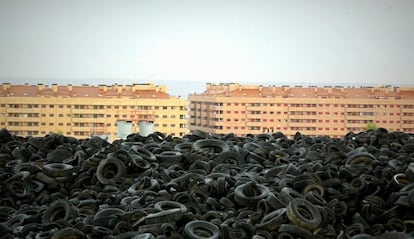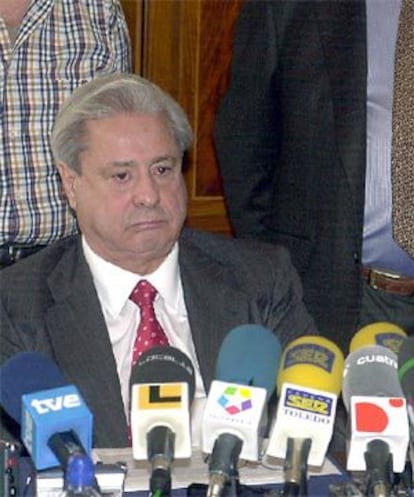Seseña’s apocalyptic rubber mountain
The town on the Madrid-Toledo border is home to a pile of more than 5m abandoned car tires

Five million car tires that that have been piled up for more than a decade on 9.8 hectares of land. The small town of Seseña, which lies on the border between Madrid and Toledo, constitutes one of Spain’s biggest environmental headaches. But the town, which is already infamous for a huge residential complex built there, which stands nearly empty, has finally come up with a plan to get rid of this rubber eyesore.
The regional governments of Madrid and Castilla-La Mancha and Seseña itself, which are all governed by the Popular Party (PP), have come up with a project to grind the nearly 100,000 tons of vehicle tires and put them to a different use.
“Erring on the side of caution, we still have between 75,000 and 90,000 tons of a very bad kind of waste in terms of its volume and nature,” says Mariano González, director general of environmental assessment for the regional government of Madrid.
Authorities say that most of this material will be recycled and turned into anything from sandals, to insulation material and pavements. A smaller portion will be burnt at cement plants after trial runs.
The mayor says that several music videos have been shot against the apocalyptic backdrop – “And no wonder”
But these explanations have failed to convince green groups, who are demanding more sustainable solutions.
In the meantime, the tire cemetery spreads like a gigantic black stain along Km 33,500 of the N-IV road linking Madrid and Andalusia. The lot is just 400 meters from El Quiñón de Seseña, the notorious residential community for 40,000 people built during the real estate boom by the developer Francisco Hernando, better known as El Pocero, a rags-to-riches entrepreneur whose nickname makes reference to his days as a sewer cleaner.
Seseña mayor Carlos Velázquez explains that several music videos have been shot against the apocalyptic backdrop of the rubber mountain. “And no wonder,” he adds.
In 2003, the site was declared in violation of environmental legislation. The company in charge of running it, Disfilt SA, ignored the warnings and kept adding to the pile. By the time it had vacated the premises after its lease expired, the company had accumulated administrative sanctions worth €600,000 and had notched up one unfavorable court ruling: in January 2009, a judge sentenced the owner to three months in prison and slapped him with a fine for environmental crimes.

“There was no electricity or running water on the premises, nor any connection to the fire hydrant. The new company in charge has all the necessary equipment to grind down the tires,” says González, of the Madrid environment department.
It was during a 2009 inspection that the Madrid government found out that the rubber mountain had grown so large that it had begun to encroach on its territory from the nearby province of Toledo, in Castilla-La Mancha.
“Despite the fines, the illegal dumping continued until 2011,” recalls the mayor of Seseña. But Velázquez is optimistic about the future.
“The new company, Gestión de Desechos y Ruedas Iberia, has all the necessary licenses and it is already operational. It is still not working at full power but we hope that by October it will hit full speed, and there could be up to three shifts,” he says.
But before the plant came under new management, a public company named Tragsa, which answers to the Agriculture Ministry, built a 30-meter thick firewall around the perimeter.
A fire could cause the shutdown of the Adolfo Suárez Madrid-Barajas airport”
“The adjacent plots are used for farming and some are left fallow. This proximity posed a huge risk,” adds the mayor.
In fact, a fire did break out at the plant once, but was caught in time. The Civil Guard’s nature protection service, Seprona, sends units out routinely to prevent a major blaze from taking hold. “The smoke could cause the shutdown of the Adolfo Suárez Madrid-Barajas airport,” warns a spokesperson for the Madrid environment department.
“Until they fixed up the perimeter, this place used to pose a tremendous danger,” adds Vicente García, a member of the green group Ecologistas en Acción. “A fire would be very difficult to put out because tire combustion is very slow. Besides cutting off air traffic, the smoke would be so toxic that the 11,000 homes in El Quiñón de Seseña would have to be evacuated... and the same if the wind blew in the direction of Valdemoro.”
And there is another “more prosaic and not in the least hypothetical” impact caused by the tower of rubber rings: the proliferation of mosquitoes in the water that collects inside the tires. “Stagnant water spreads disease,” notes García.
Tu suscripción se está usando en otro dispositivo
¿Quieres añadir otro usuario a tu suscripción?
Si continúas leyendo en este dispositivo, no se podrá leer en el otro.
FlechaTu suscripción se está usando en otro dispositivo y solo puedes acceder a EL PAÍS desde un dispositivo a la vez.
Si quieres compartir tu cuenta, cambia tu suscripción a la modalidad Premium, así podrás añadir otro usuario. Cada uno accederá con su propia cuenta de email, lo que os permitirá personalizar vuestra experiencia en EL PAÍS.
¿Tienes una suscripción de empresa? Accede aquí para contratar más cuentas.
En el caso de no saber quién está usando tu cuenta, te recomendamos cambiar tu contraseña aquí.
Si decides continuar compartiendo tu cuenta, este mensaje se mostrará en tu dispositivo y en el de la otra persona que está usando tu cuenta de forma indefinida, afectando a tu experiencia de lectura. Puedes consultar aquí los términos y condiciones de la suscripción digital.
Últimas noticias
Maduro pleads not guilty before the federal court in New York: ‘I am still the president of Venezuela’
A new test can detect Alzheimer’s from a finger prick
UN team enters Sudanese city of El Fasher after paramilitary massacre: ‘It’s like a ghost town’
A recipe for resistance: Indigenous peoples politicize their struggles from the kitchen
Most viewed
- Gilles Lipovetsky: ‘If you want to live better and fall in love, take Prozac, don’t look to philosophy’
- Alain Aspect, Nobel laureate in physics: ‘Einstein was so smart that he would have had to recognize quantum entanglement’
- Alvin Hellerstein, a 92-year-old judge appointed by Bill Clinton, to preside over Maduro’s trial in New York
- Why oil has been at the center of Venezuela-US conflicts for decades
- Cuba confirms death of 32 of its citizens in the US attack against Venezuela








































